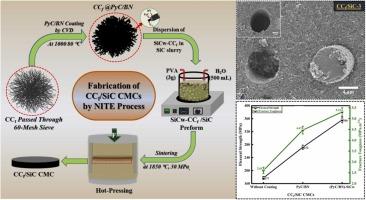NITE工艺制备CCf/SiC复合材料中PyC/BN界面相和SiC晶须的双重增韧机制
IF 6.3
2区 材料科学
Q2 CHEMISTRY, PHYSICAL
引用次数: 0
摘要
短切碳纤维(CCf)增强SiC陶瓷基复合材料(CCf/SiC CMCs)是一种极具潜力的热结构材料。在这项工作中,我们研究了通过化学气相沉积(CVD)沉积的双保护界面(热解碳/氮化硼(PyC/BN))以及掺杂SiC晶须(SiCw)含量(20 wt%)对NITE工艺制备的CCf/SiC cmc的结构和性能的影响。利用先进的表征工具对其结构和力学特性进行了表征。PyC/BN双保护界面相的引入有效地保持了其在高温下的完整性,并通过纤维拔出和界面脱粘机制显著提高了韧性。此外,加入20%的SiC晶须(SiCw)作为二次增强剂可以产生协同增韧效果,促进裂纹桥接和纤维拉出行为。这种双重增韧机制显著提高了材料的力学性能,其最优抗弯强度为~356±9.089 MPa,最优韧性为~5.31±0.194 MPa,最优韧性为~5.31±0.194 MPa。此外,SiCw的加入有助于形成空间网络结构,潜在地减少了热膨胀。本研究的见解促进了对CCf/SiC复合材料微结构工程的理解,使未来的低成本设计和制造高性能复合材料用于极端环境。本文章由计算机程序翻译,如有差异,请以英文原文为准。

Dual Toughening Mechanisms Via PyC/BN Interphases and SiC Whiskers in CCf/SiC Composites Fabricated by NITE Process
Chopped carbon fiber (CCf) reinforced SiC ceramic matrix composites (CCf/SiC CMCs) hold potential as thermal structural materials. In this work, we investigated the impacts of dual protective interphases (pyrolytic carbon/boron nitride (PyC/BN)) deposited via chemical vapor deposition (CVD), along with the incorporation SiC whiskers (SiCw) contents (20 wt%) on the structure and properties of as-fabricated CCf/SiC CMCs by NITE route. Structural and mechanical characteristics were explicated by the relevant advanced characterization tools. The introduction of PyC/BN dual protective interphase effectively preserved its integrity at elevated temperature and improved the toughness significantly via fiber pull-out and interfacial debonding mechanisms. Furthermore, incorporating 20 wt% SiC whiskers (SiCw) as secondary reinforcement yielded a synergistic toughening effect, promoting both the crack bridging and fiber pull-out behavior. This dual toughening mechanism led to a notable enhancement in mechanical performance, revealing an optimum bending strength of ~356 ± 9.089 MPa, and toughness of ~5.31 ± 0.194 MPa⊡m1/2. Additionally, the inclusion of SiCw contributed to the creation of spatial network structure, potentially reducing the thermal expansion. The insights from this study advance the understanding of microstructural engineering in CCf/SiC composites, enabling future low-cost design and manufacturing of high-performance composites for extreme environments.
求助全文
通过发布文献求助,成功后即可免费获取论文全文。
去求助
来源期刊

Journal of Alloys and Compounds
工程技术-材料科学:综合
CiteScore
11.10
自引率
14.50%
发文量
5146
审稿时长
67 days
期刊介绍:
The Journal of Alloys and Compounds is intended to serve as an international medium for the publication of work on solid materials comprising compounds as well as alloys. Its great strength lies in the diversity of discipline which it encompasses, drawing together results from materials science, solid-state chemistry and physics.
 求助内容:
求助内容: 应助结果提醒方式:
应助结果提醒方式:


